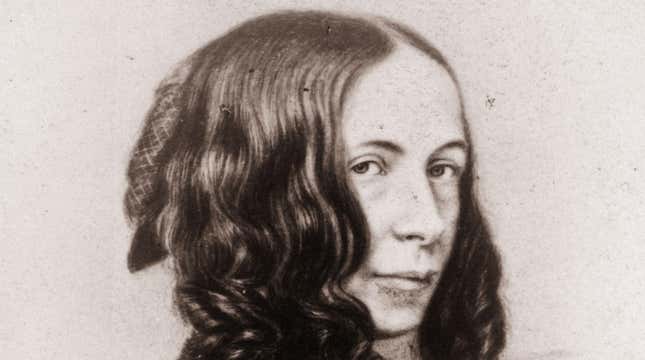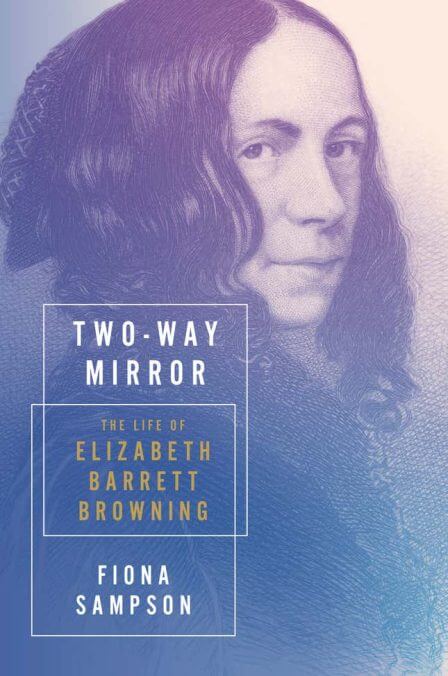The Long Swoon of Elizabeth Barrett Browning
How an influential, vital artist was reduced to a passive pile of ruffles in the cultural consciousness
BooksEntertainment
Image: (Photo by Elliott & Fry/Otto Herschan Collection/Getty Images)
Fiona Sampson’s latest book, Two-Way Mirror: The Life of Elizabeth Barrett Browning, is available now.
What does the name Elizabeth Barrett Browning evoke for you? For me, it’s the battered high school desk in which, on my very first day of Big School, I found an abandoned poetry book. For the rest of that year, reading this stained volume furtively under the desk lid helped me deal with classroom boredom and all the social upsets of a new school. When one day I discovered that it included a woman, it was like stumbling on a private sign that the world of writers and writing could be open to me, too. Ever since that first encounter with Elizabeth Barrett Browning, I’ve believed in the power of role models. The women who went before us pass us the baton with a nod and wink of recognition, a handshake of complicity.
Yet all too often Barrett Browning’s name evokes nothing more interesting than ringlets, Victorian lace, and life on a chaise longue. The powerful figure of this pioneering social advocate and literary innovator, who in her relatively short life from 1806 to 1861 achieved the nineteenth-century equivalent of international celebrity, has been largely erased from public awareness. The real-life writer so fiercely admired by peers and literary successors from John Ruskin to Oscar Wilde, Hans Christian Anderson to Rudyard Kipling, Emily Dickinson to George Eliot, has vanished. Her replacement reclines on the Freudian couch, vanquished by emotion, wearing immaculate makeup and a succession of lavish frocks, one of the cultural clichés of the second half of the twentieth century. The Swooning Lady poetess (I’m using the diminutive advisedly) lodges in the pantheon of popular cultural archetypes, alongside Boris Karloff as Frankenstein’s creature and the apotheosis of Bonnie and Clyde.

The real Elizabeth Barrett Browning, on the other hand, born almost exactly mid-way between Mary Shelley (1797) and Charlotte Brontë (1816), was a precociously gifted bundle of energy: her first book was published on her fourteenth birthday. Despite family wealth, conventions of the time forced her to be something of an autodidact from the start, “borrowing” her brother’s tutors and reading round her father’s library. Despite the patronizing reactions of critics who “congratulate […] women, competent to …spell,” in 1850 she was the first woman nominated to be the UK’s Poet Laureate, 159 years before one was actually appointed. Along with Alfred Tennyson (appointed in her stead), she was pioneering the shift from Romanticism to a new kind of writing. This exciting, accessible poetry was less concerned with radical abstract ideas than feelingful storytelling; not so elevated in diction but more discursive and descriptive. Her younger husband Robert Browning, whom she married at forty, would learn from these techniques and carry them forward after her death. 160 years later, Barrett Browning is still Britain’s leading woman poet and her “Sonnets from the Portuguese” (1850) include what is officially the Nation’s Favourite Poem, “How do I love thee? Let me count the ways.” Her 1856 verse novel Aurora Leigh was the first in the influential, originally Romantic genre of the bildungsroman, that intimate story of how personhood develops, to be written by and about a woman. In fact, Aurora Leigh is also the first woman’s künstlerroman, telling the story of how a woman becomes an artist. This late masterpiece is feminism avant la lettre: a subplot protests the trafficking of women, understands forced prostitution as rape, and supports a mother’s right to raise the child of that rape as a single parent.
Bold material for a woman writer in Victorian England; as bold in its way as putting her own name on the title page. Barrett Browning always did so, although most of her distinguished women contemporaries preferred a male pseudonym (the Brontë sisters as the Bell brothers, George Eliot, George Sand) or anonymity (“the author of Frankenstein” or, in Jane Austen’s case, “a lady”). There’s a kind of standing up for what one believes in this. Barrett Browning was a woman of strong convictions, actively engaged with the religious debates of her time, from congregational worship to Swedenborgism and even Spiritualism, who believed in the ethical role of poetry. She addressed a new mass reading public, and—unafraid of unpopular causes—helped shift popular opinion on child labor, abolition (in the US), and Italian republicanism, the subject of two of her books, Casa Guidi Windows (1851) and Poems Before Congress (1860). When she died in Florence in 1861, she was buried with civic honors as a heroine of the Risorgimento.
It’s inspiring stuff, and would make a great movie; yet for nearly a century this public, active life has been turned inside out by a simpering caricature. The fictional “Elizabeth Barrett Browning” has been played by a constellation of women stars: Norma Shearer, Jennifer Jones, Katharine Cornell, Jane Lapotaire; their vehicle, The Barretts of Wimpole Street, a ‘Comedy in Five Acts’ by a Dutch-British playwright called Rudolf Besier.

Besier may have been something of a one-hit wonder: but a success his 1930 “comedy” certainly was. After its British premiere, at the Malvern Festival Theatre, Cornell brought the play to Broadway in 1934. It was a hit, as were two subsequent productions. The film versions that followed included two by Sidney Franklin. In 1934, his Elizabeth was Norma Shearer; not content with this, his 1957 remake used the exact same script but substituted Jennifer Jones and, in a weak gesture towards authenticity, was filmed in a UK studio. By the time Jane Lapotaire starred in a 1982 made-for-TV movie, there had been seven TV productions of the play in the UK and the US, and—worst of all, I’d argue—a musical. Opening in 1964, Ron Grainer and Ronald Millar’s Robert and Elizabeth was a West End hit which ran for more than 900 performances. Now Elizabeth was played by June Bronhill, and the story told in such numbers as “Want to be well” and “Pass the eau-de-Cologne.” The glamour shot on the cover of the Original Cast Recording shows the shingled Bronhill clutched by a Robert Browning (John Clements) with Teddy Boy sideburns.
It’s glorious camp. But my point in all this isn’t pop culture geekery. This is cultural myth-making in action, and watching it happen to a key historical figure is both fascinating and frustrating. (So much so that I recently found myself writing the first full-length literary biography of Barrett Browning since the 1980s.) As Mel Brooks demonstrated in 1967’s The Producers, there’s no better way to draw the sting of something you fear than reducing it to kitsch. Putting a woman writer in her place may not be as audacious as performing “Springtime for Hitler and Germany,” and Robert and Elizabeth, like the Besier play it’s based on, is full of ostensibly straightforward sentiment. But that all these versions were so successful points to something going on.
-

-

-

-

-

-

-

-

-

-

-

-

-

-

-

-

-

-

-

-

-

-

-

-

-

-

-

-

-

-

-

-

-

-

-

-

-

-

-

-








































